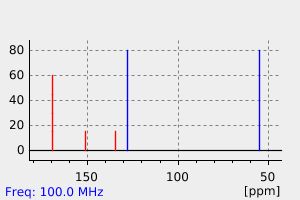5-苯基巴比妥酸 | 22275-34-9
中文名称
5-苯基巴比妥酸
中文别名
——
英文名称
5-phenyl-2,4,6-pyrimidinetrione
英文别名
5-Phenylbarbitursaeure;5-phenylbarbituric acid;5-phenyl-1,3-diazinane-2,4,6-trione
CAS
22275-34-9
化学式
C10H8N2O3
mdl
——
分子量
204.185
InChiKey
HTEHILLCBQWTLP-UHFFFAOYSA-N
BEILSTEIN
——
EINECS
——
-
物化性质
-
计算性质
-
ADMET
-
安全信息
-
SDS
-
制备方法与用途
-
上下游信息
-
文献信息
-
表征谱图
-
同类化合物
-
相关功能分类
-
相关结构分类
物化性质
-
熔点:264-266 °C
-
密度:1.341±0.06 g/cm3(Predicted)
-
溶解度:二甲亚砜、甲醇(热)
计算性质
-
辛醇/水分配系数(LogP):0.5
-
重原子数:15
-
可旋转键数:1
-
环数:2.0
-
sp3杂化的碳原子比例:0.1
-
拓扑面积:75.3
-
氢给体数:2
-
氢受体数:3
安全信息
-
海关编码:2933540000
SDS
上下游信息
-
上游原料
中文名称 英文名称 CAS号 化学式 分子量 2-苯基丙二酰胺 2-phenylmalonamide 10255-95-5 C9H10N2O2 178.191 -
下游产品
中文名称 英文名称 CAS号 化学式 分子量 —— 5-hydroxy-5-phenylbarbitursaeure 22458-15-7 C10H8N2O4 220.185 —— 5-Chlor-2,4,6-trioxo-5-phenyl-hexahydropyrimidin 3120-27-2 C10H7ClN2O3 238.63 —— 5-fluoro-5-phenylbarbituric acid 53162-61-1 C10H7FN2O3 222.176 —— 5-Phenyl-5-brombarbitursaeure 5750-80-1 C10H7BrN2O3 283.081 苯巴比妥 phenobarbital 50-06-6 C12H12N2O3 232.239 苯烯比妥 5-allyl-5-phenylbarbituric acid 115-43-5 C13H12N2O3 244.25 5-苄基-5-苯基巴比妥酸 5-benzyl-5-phenyl-barbituric acid 93841-22-6 C17H14N2O3 294.31 5-(2-甲基-2-丙烯基)-5-苯基巴比妥酸 5-methallyl-5-phenyl-barbituric acid 67051-53-0 C14H14N2O3 258.277
反应信息
-
作为反应物:描述:参考文献:名称:Aspelund, Acta Academiae Aboensis, Series B: Mathematica et Physica, 7 Nr 13 <1933> 6摘要:DOI:
-
作为产物:参考文献:名称:5,5-二苯基-巴比妥尔,5-苯基-5-环-己基-巴比妥尔和5-苯基-5-环-己烯基-巴比妥尔摘要:DOI:10.1002/hlca.193501801175
文献信息
-
Method for detecting uracil biosynthesis inhibitors and their use as herbicides申请人:——公开号:US20020058244A1公开(公告)日:2002-05-16This invention relates to a method for identifying compounds that specifically inhibit a metabolic target site or pathway in plants. Enzymes which are specifically affected by the method of the invention include plant pyrimidine biosynthetic pathway enzymes, and particularly the enzymes involved in the conversion of orotate to uridine-5′-monophosphate (UMP). Further, the invention relates to a method for control of undesirable monocotyledenous and dicotyledenous plant species.
-
POLARIZING PLATE PROTECTIVE FILM, POLARIZING PLATE, AND DISPLAY DEVICE申请人:FUJIFILM Corporation公开号:US20170226317A1公开(公告)日:2017-08-10A polarizing plate protective film which prevents deterioration of polarization performance in a high temperature, high humidity environment, and a polarizing plate and display device using the film including a compound represented by the following General Formula (I). (X-L n z General Formula (I) X represents a formyl group, a boronic acid group, or a group represented by the following General Formula (I-B) or a group represented by the following General Formula (I-C), where L represents a single bond or divalent linking group, and n represents an integer equal to or greater than 2. When n is 2, Z represents a single bond or a divalent group, and when n≧3, Z represents an n-valent group. R A and R B represent an alkyl group, a cycloalkyl group, an aryl group, or an acyl group. R A and R B may be bonded to each other to form a ring. * represents a bond to be bonded to L.一种偏光板保护膜,可防止在高温高湿环境中偏光性能的恶化,以及使用包括下述一般式(I)所代表的化合物的偏光板和显示装置。 (X-L n z 一般式(I) X代表甲酰基、硼酸基或由下述一般式(I-B)所代表的基团或由下述一般式(I-C)所代表的基团,其中L代表单键或二价连接基团,n代表大于或等于2的整数。当n为2时,Z代表单键或二价基团,当n≧3时,Z代表n价基团。 RA和RB代表烷基、环烷基、芳基或酰基。RA和RB可以相互连接形成环。*代表要连接到L的键。
-
Discovery of 5-Substituted-6-chlorouracils as Efficient Inhibitors of Human Thymidine Phosphorylase作者:Radim Nencka、Ivan Votruba、Hubert Hřebabecký、Petr Jansa、Eva Tloušt'ová、Květa Horská、Milena Masojídková、Antonín HolýDOI:10.1021/jm070644i日期:2007.11.1that 6-halouracils substituted at position C5 by certain hydrophobic groups exhibit significant inhibitory activity against this enzyme. The most potent compounds bear a five- or six-membered cyclic substituent containing a pi-electron system at C5 and a chlorine atom attached at C6. 6-Chloro-5-cyclopent-1-en-1-yluracil 7a is the most efficient derivative in this study, with Ki = 0.20 +/- 0.03 microM胸苷磷酸化酶在血管生成中起重要作用,这是治疗癌症和其他疾病的有吸引力的靶标。在我们不断努力开发新型胸苷磷酸化酶抑制剂的过程中,我们发现在C5位置被某些疏水基团取代的6-氟尿嘧啶对这种酶表现出显着的抑制活性。最有效的化合物带有一个五元或六元环状取代基,在C5处含有一个π电子系统,在C6处含有一个氯原子。6-氯-5-环戊-1-烯-1-基尿嘧啶7a是这项研究中最有效的衍生物,对于在V79细胞和Ki中表达的胸苷磷酸化酶,Ki = 0.20 +/- 0.03 microM(Ki / dThdKm = 0.0017)从胎盘中纯化的酶为0.29 +/- 0.04 microM(Ki / dThdKm = 0.0024)。
-
[EN] N-HYDROXYLAMINO-BARBITURIC ACID DERIVATIVES AS NITROXYL DONORS<br/>[FR] DÉRIVÉS D'ACIDE N-HYDROXYLAMINO-BARBITURIQUE UTILISÉS COMME DONNEURS DE NITROXYLE申请人:UNIV JOHNS HOPKINS公开号:WO2015183838A1公开(公告)日:2015-12-03The present disclosure provides N-hydroxylamino-barbituric acid compounds of formulae (1)- (4), pharmaceutical compositions and kits comprising them, and methods of using such compounds or pharmaceutical compositions. The present disclosure provides methods of using such compounds or pharmaceutical compositions for treating heart failure.
-
Synthesis and binding properties of chiral macrocyclic barbiturate receptors: application to nitrile oxide cyclizations作者:Brian S. Rasmussen、Unai Elezcano、Troels SkrydstrupDOI:10.1039/b110865b日期:2002.7.11A series of chiral macrocyclic receptors containing a barbiturate binding domain based on two 2,6-diaminopyridine groups has been synthesized with the purpose of exploiting these for asymmetric 1,3-dipolar cycloadditions. Each macrocyclic host was built possessing an (R)-BINOL or a modified deoxycholate moiety as the chiral unit connected to the barbiturate binding domain with varying lengths of spacer. All the hosts with the exception of one were found to effectively bind a barbiturate–cinnamic acid conjugate with association constants in the order of 104 M−1 in CDCl3. The 1,3-dipolar cycloaddition between several arylnitrile oxides and the cinnamate conjugates were examined in the presence of stoichiometric amounts of a chiral receptor affording two regioisomeric isoxazolines. Enantiomeric excesses of up to 30% were obtained in one case for the major regioisomer. In most cases, the enantiomeric excesses could be measured directly from the crude 1H-NMR spectra owing to the diastereomeric interaction between the isoxazoline cycloadduct and the chiral receptor. The relatively low enantiofacial selectivities at the CC double bond of the cinnamate were attributed to the non-planar orientation of the barbiturate–cinnamate conjugate with respect to the receptor, as previously noted for the binding of barbital to an achiral macrocyclic host (S.-K., Chang, E. Fan, D. Van Engen and A. D. Hamilton, J. Am. Chem. Soc., 1991, 113, 7640), directing the cinnamate unit away from the chiral unit.一系列基于两个2,6-二氨基吡啶基团的巴比妥酸盐结合域的手性大环受体已被合成,旨在利用它们进行不对称的1,3-偶极环加成反应。每个大环主体构建时含有一个(R)-BINOL或修饰的脱氧胆酸部分作为手性单元,通过不同长度的间隔基与巴比妥酸盐结合域相连。除一种外,所有受体均能有效结合巴比妥酸盐-肉桂酸共轭物,其在CDCl3中的结合常数为10^4 M^-1数量级。在手性受体的定量存在下,考察了几种芳基腈氧化物与肉桂酸共轭物之间的1,3-偶极环加成反应,生成两种区域异构的异恶唑啉。在某例中,主要区域异构体的对映体过量达到30%。在多数情况下,由于异恶唑啉环加合物与手性受体之间的非对映异构相互作用,对映体过量可以直接从粗1H-NMR谱图中测得。肉桂酸在CC双键处的相对较低的对映选择性归因于巴比妥酸盐-肉桂酸共轭物相对于受体的非平面取向,这一点与以前报道的巴比妥酸盐与非手性大环受体的结合情况相似(Chang等,1991),导致肉桂酸部分远离手性单元。
表征谱图
-
氢谱1HNMR
-
质谱MS
-
碳谱13CNMR
-
红外IR
-
拉曼Raman
-
峰位数据
-
峰位匹配
-
表征信息
同类化合物
(S)-3-(2-(二氟甲基)吡啶-4-基)-7-氟-3-(3-(嘧啶-5-基)苯基)-3H-异吲哚-1-胺
(6-羟基嘧啶-4-基)乙酸
(4,5-二甲氧基-1,2,3,6-四氢哒嗪)
鲁匹替丁
马西替坦杂质7
马西替坦杂质4
马西替坦杂质
马西替坦原料药杂质D
马西替坦原料药杂质B
马西替坦
顺式-4-{[5-溴-2-(2,5-二甲基-1H-吡咯-1-基)-6-甲基嘧啶-4-基]氨基}环己醇
非沙比妥
非巴氨酯
非尼啶醇
青鲜素钾盐
雷特格韦钾盐
雷特格韦相关化合物E(USP)
雷特格韦杂质8
雷特格韦EP杂质H
雷特格韦-RT9
雷特格韦
阿西莫司杂质3
阿西莫司
阿脲四水合物
阿脲一水合物
阿维霉素
阿米美啶
阿米洛利
阿米妥钠
阿洛巴比妥
阿普瑞西他滨
阿普比妥
阿巴卡韦相关化合物B(USP)
阿卡明
阿伐那非杂质V
阿伐那非杂质1
阿伐那非杂质
阿伐那非中间体
阿伐那非
铂(2+)二氯化6-甲基-1,3-二{2-[(2-甲基丙基)硫烷基]乙基}嘧啶-2,4(1H,3H)-二酮(1:1)
钴1,2,3,6-四氢-2,6-二氧代嘧啶-4-羧酸酯(1:2)
钠5-烯丙基-4,6-二氧代-1,4,5,6-四氢-2-嘧啶醇酸酯
钠5-乙基-4,6-二氧代-1,4,5,6-四氢-2-嘧啶醇酸酯
钠5-(2-溴丙-2-烯基)-5-丁烷-2-基-4,6-二氧代-1H-嘧啶-2-醇
醌肟腙
酒石酸噻吩嘧啶
那可比妥
辛基2,6-二氧代-1,2,3,6-四氢-4-嘧啶羧酸酯
赛乐西帕杂质3
赛乐西帕KSM3







